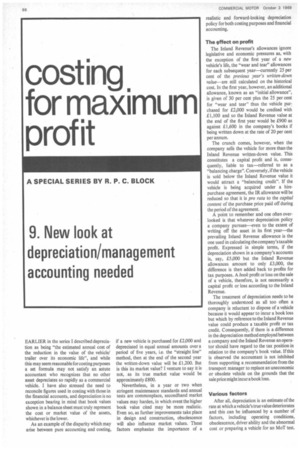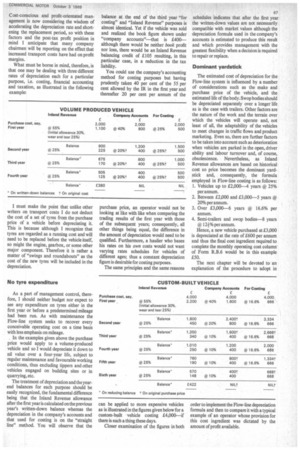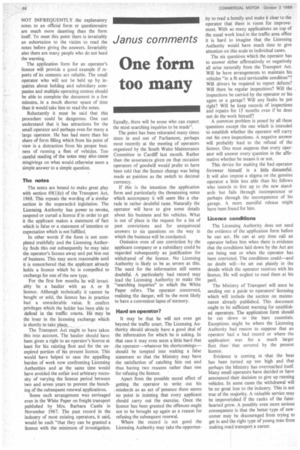costing for maximum profit
Page 72

Page 73

Page 74

If you've noticed an error in this article please click here to report it so we can fix it.
A SPECIAL SERIES BY R. P. C. BLOCK
9. New look at depreciation/management accounting needed
EARLIER in the series I described depreciation as being "the estimated annual cost of the reduction in the value of the vehicle/ trailer over its economic life", and while this may seem reasonable for costing purposes a set formula may not satisfy an astute accountant who recognizes that no other asset depreciates so rapidly as a commercial vehicle. I have also stressed the need to reconcile figures used in costing with those in the financial accounts, and depreciation is no exception bearing in mind that book values shown in a balance sheet must truly represent the cost or market value of the assets, whichever is the lower.
As an example of the disparity which may arise between pure accounting and costing, if a new vehicle is purchased for £2,000 and depreciated in equal annual amounts over a period of five years, i.e. the "straight line" method, then at the end of the second year the written-down value will be £1,200. But is this its market value? I venture to say it is not, as its true market value would be approximately £800.
Nevertheless, in a year or two when stringent maintenance standards and annual tests are commonplace, secondhand market values may harden, in which event the higher book value cited may be more realistic. Even so, as further improvements take place in design and construction, obsolescence will also influence market values. These factors emphasize the importance of a realistic and forward-looking depreciation policy for both costing purposes and financial accounting.
The effect on profit
The Inland Revenue's allowances ignore legislative and economic pressures as, with the exception of the first year of a new vehicle's life, the "wear and tear" allowances for each subsequent year—currently 25 per cent of the previous year's written-down value—are still calculated on the historical cost. In the first year, however, an additional allowance, known as an "initial allowance", is given of 30 per cent plus the 25 per cent for "wear and tear" thus the vehicle purchased for £2,000 would be credited with £1,100 and so the Inland Revenue value at the end of the first year would be £900 as against £1,600 in the company's books if being written down at the rate of 20 per cent• per annum.
The crunch comes, however, when the company sells the vehicle for more than the Inland Revenue written-down value. This constitutes a capital profit and is, consequently, liable to tax—referred to as a "balancing charge". Conversely, if the vehicle is sold below the Inland Revenue value it would attract a "balancing credit". If the vehicle is being acquired under a hirepurchase agreement, the IR allowance will be reduced so that it is pro rata to the capital content of the purchase price paid off during the period of the agreement.
A point to remember and one often overlooked is that whatever depreciation policy a company pursues—even to the extent of writing off the asset in its first year—the prevailing Inland Revenue allowance is the one used in calculating the company's taxable profit. Expressed in simple terms, if the depreciation shown in a company's accounts is, say, £5,000 but the Inland Revenue allowances amount to only £3,000, the difference is then added back to profits for tax purposes. A book profit or loss on the sale of a vehicle, therefore, is not necessarily a capital profit or loss according to the Inland Revenue.
The treatment of depreciation needs to be thoroughly understood as all too often a company is reluctant to dispose of a vehicle because it would appear to incur a book loss but which by reference to the Inland Revenue value could produce a taxable profit or tax credit. Consequently, if there is a difference in the depreciation method employed between a company and the Inland Revenue an operator should have regard to the tax position in relation to the company's book value. If this is observed the accountant is not inhibited from supporting a recommendation from the transport manager to replace an uneconomic or obsolete vehicle on the grounds that the sale price might incur a book loss.
Various factors After all, depreciation is an estimate of the rate at which a vehicle's true value deteriorates and this can be influenced by a number of factors, including operating conditions, obsolescence, driver ability and the abnormal cost or preparing a vehicle for an MoT test. Cost-conscious and profit-orientated management is now considering the wisdom of accelerating the depreciation rate and shortening the replacement period, so with these factors and the post-tax profit position in mind I anticipate that many company chairmen will be reporting on the effect that increased transport costs have had on profit margins.
What must be borne in mind, therefore, is that one may be dealing with three different rates of depreciation each for a particular purpose, i.e. costing, financial accounting and taxation, as illustrated in the following example: I must make the point that unlike other writers on transport costs I do not deduct the cost of a set of tyres from the purchase price of a vehicle before depreciating it. This is because although I recognize that tyres are regarded as a running cost and will need to be replaced before the vehicle itself, so might the engine, gearbox, or some other major component. Therefore it is rather a matter of "swings and roundabouts" as the cost of the new tyres will be included in the depreciation.
No tyre expenditure As a part of management control, therefore, I should neither budget nor expect to see any expenditure on tyres either in the first year or before a predetermined mileage had been run. As with maintenance the Flow-line system seeks to recover every conceivable operating cost on a time basis with less emphasis on mileage.
, In the examples given above the purchase price would apply to a volume-produced vehicle and so I would depreciate it down to nil value over a four-year life, subject to regular maintenance and favourable working conditions, thus excluding tippers and other vehicles engaged on building sites or in quarrying, etc.
The treatment of depreciation and the yearend balances for each purpose should be easily recognized, the fundamental difference being that the Inland Revenue allowance after the first year is calculated on the previous year's written-down balance whereas the depreciation in the company's accounts and that used for costing is on the "straight line" method. You will observe that the
balance at the end of the third year "for costing" and "Inland Revenue" purposes is almost identical. Yet if the vehicle was sold and realized the book figure shown under "company accounts"—that is £400— although there would be neither book profit nor loss, there would be an Inland Revenue balancing credit of £105 resulting, in this particular case, in a reduction in the tax liability.
You could use the company's accounting method for costing purposes but having prudently taken 40 per cent of the 55 per cent allowed by the IR in the first year and thereafter 20 per cent per annum of the
purchase price, an operator would not be looking at like with like when comparing the trading results of the first year with those of the subsequent years; consequently, all other things being equal, the difference in the amount of depreciation would need to be qualified. Furthermore, a haulier who bases his rates on his own costs would not want varying rates schedules for vehicles of different ages; thus a constant depreciation figure is desirable for costing purposes.
The same principles and the same reasons schedules indicates that after the first year the written-down values are not necessarily compatible with market values although the depreciation formula used in the company's accounts is estimated to produce this result and which provides management with the greatest flexibility when a decision is required to repair or replace.
Dominant yardstick The estimated cost of depreciation for the Flow-line system is influenced by a number of considerations such as the make and purchase price of the vehicle, and the estimated life of the body. Swop bodies should be depreciated separately over a longer life as is the case with trailers. Other factors are the nature of the work and the terrain over which the vehicles will operate and, not least of all, the adaptability of the vehicles to meet changes in traffic flows and product marketing. Even so, there are further factors to be taken into account such as deterioration when vehicles are parked in the open, driver ability and labour turnover and, of course, obsolescence. Nevertheless, as Inland Revenue allowances are based on historical cost so price becomes the dominant yardstick and, consequently, the formula employed in Flow-line costing is as follows: 1. Vehicles up to £2,000-4 years @ 25% per annum.
2. Between £2,000 and £3,000-5 years @ 20% per annum.
3. Over £3,000-6 years @ 16.6% per annum.
4. Semi-trailers and swop bodies-8 years 12-1-% per annum.
Hence, a new vehicle purchased at £3,000 is depreciated at the rate of £600 per annum and thus the final cost ingredient required to complete the monthly operating cost column of Form R.B.6 would be in this example £50.
The next chapter will be devoted to an explanation of the procedure to adopt in NOT INFREQUENTLY the explanatory notes to an official form or questionnaire are much more daunting than the form itself_ To meet this point there is invariably an exhortation to the victim to read the notes before giving the answers. Invariably also there are many people who do not heed the warning.
The application form for an operator's licence will provide a good example if reports of its contents are reliable. The small operator who will not be held up by inquiries about holding and subsidiary companies and multiple operating centres should be able to complete the document in a few minutes, in a much shorter space of time than it would take him to read the notes.
Reluctantly it must be said that this procedure could be dangerous. One can understand that it has attractions for the small operator and perhaps even for many a large operator. He has had more than his share of form filling which from his point of view is a distraction from his proper business of running a fleet of vehicles. Too careful reading of the notes may also cause misgivings on what would otherwise seem a simple answer to a simple question.
The notes The notes are bound to make great play with section 69(1)(c) of the Transport Act, 1968. This repeats the wording of a similar section in the superseded legislation. The Licensing Authority has power to revoke, suspend or curtail a licence if in order to get it the applicant makes a statement of fact which is false or a statement of intention or expectation which is not fulfilled.
In other words if the form is not completed truthfully and the Licensing Authority finds this out subsequently he may take the operator's licence away and put him out of business. This may seem reasonable until it is remembered that the applicant already holds a licence which he is compelled to exchange for one of the new type.
For the first few months he will invariably be a haulier with an A or B licence. Although technically it cannot be bought or sold, the licence has in practice had a considerable value. It confers privileges which the holder has been able to defend in the traffic courts. He may be the loser in the licensing exchange which is shortly to take place.
The Transport Act ought to have taken this into account. The haulier should have been given a right to an operator's licence at least for his existing fleet and for the unexpired portion of his present licence. This would have helped to ease the appalling burden of work now confronting Licensing Authorities and at the same time would have avoided the unfair and arbitrary necessity of varying the licence period between two and seven years to prevent the bunching of the subsequent renewal applications.
Some such arrangement was envisaged even in the White Paper on freight transport published by Mrs. Barbara Castle in November 1967. The past record in the industry of most existing operators, it said, would be such "that they can be glinted a licence with the minimum of investigation.




































































































































